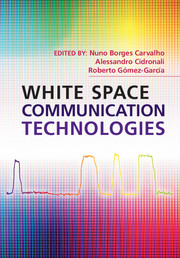Book contents
- Frontmatter
- Contents
- List of contributors
- Preface
- List of abbreviations
- Part I White space technology signal processing and digital design
- Part II Adaptable receivers for white space technologies
- Part III Adaptable transceivers for white space technologies
- 7 White spaces exploration using FPGA-based all-digital transmitters
- 8 Interference active cancelation techniques for agile transceivers
- 9 Highly efficient transmitter architectures
- Index
- References
8 - Interference active cancelation techniques for agile transceivers
from Part III - Adaptable transceivers for white space technologies
Published online by Cambridge University Press: 05 October 2014
- Frontmatter
- Contents
- List of contributors
- Preface
- List of abbreviations
- Part I White space technology signal processing and digital design
- Part II Adaptable receivers for white space technologies
- Part III Adaptable transceivers for white space technologies
- 7 White spaces exploration using FPGA-based all-digital transmitters
- 8 Interference active cancelation techniques for agile transceivers
- 9 Highly efficient transmitter architectures
- Index
- References
Summary
Introduction
The growing need for spectrum for telecommunications is sustained by two possible main streams: the increase in spectrum efficiency and the increased capability to fill the temporary spectrum empty spaces. While the first is aimed at improving radio access technologies, making the signal waveforms more complex and thus more demanding in terms of transmitter linearity, the second approach requires transceiver flexibility in order to adapt the parameters according to channel occupancy in an opportunistic way. Opportunity is shown by on-field measurements which, in the below 6 GHz band-width, have shown that actual utilization at the time, place and direction is 0.25% in the 3–4 GHz band, and drops to 0.13% for the 4–5 GHz band, while does not exceed 5% in 5–6 GHz. Even in the most congested bands, such as below 2 GHz, utilization is less than 50%. It is clear that allocations are not all being utilized by their expected users: the priority users (PU). Chapter 1 provides a comprehensive discussion of the topic across the world. The availability of white spaces is taken by the cognitive radio (CR) approach, provided that the spectrum sensing and transceiver reconfigurability are performed over the widest spectrum band to give the highest effectiveness in the use of unused spectra [1].
Information
- Type
- Chapter
- Information
- White Space Communication Technologies , pp. 231 - 261Publisher: Cambridge University PressPrint publication year: 2014
References
Accessibility standard: Unknown
Why this information is here
This section outlines the accessibility features of this content - including support for screen readers, full keyboard navigation and high-contrast display options. This may not be relevant for you.Accessibility Information
- 1
- Cited by
